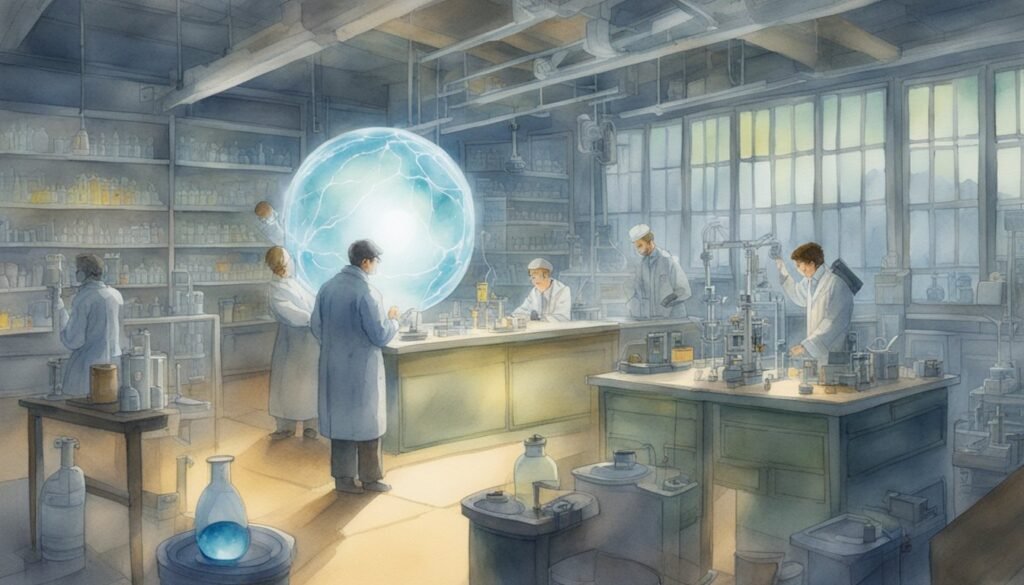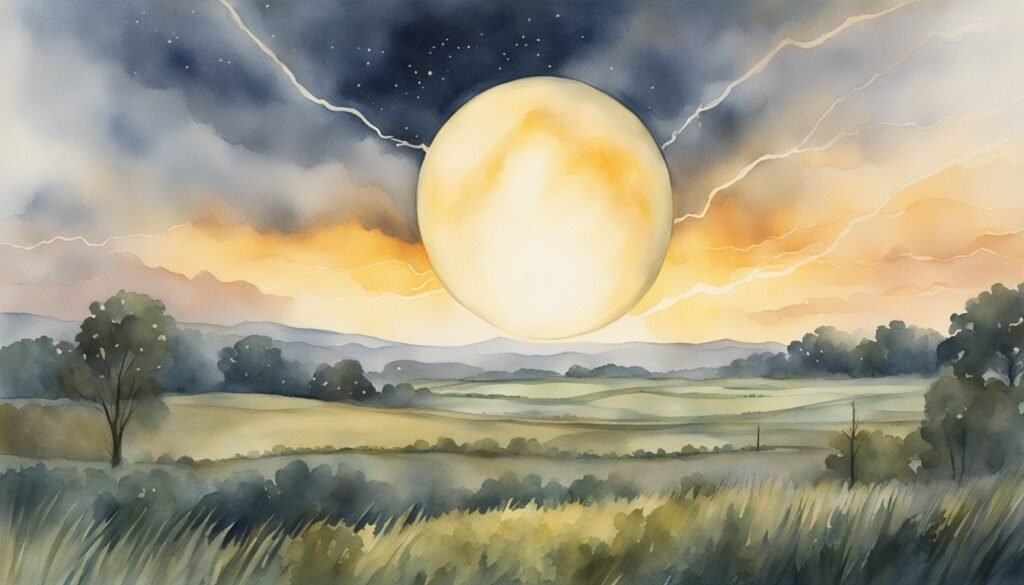Phenomenology of Ball Lightning
Ball lightning has intrigued scientists and enthusiasts alike due to its peculiar characteristics, which differ significantly from the common streak lightning. This section takes a closer look at the visual aspects and behaviors of this mysterious phenomenon.
Visual Characteristics
Ball lightning appears as luminous balls in the sky, typically with a diameter ranging from a few centimeters to a meter. Its colors span the spectrum from red, orange, blue, yellow, to white. The precise color can vary, but these glowing balls often have a vivid, eerie luminosity that makes them stand out against the backdrop of a stormy sky.
- Color Variations: The color displayed by ball lightning may be influenced by factors such as atmospheric composition and the energy levels of the charged particles within.
Duration and Behavior
Unlike the instantaneous flash of traditional lightning, ball lightning tends to last much longer. These glowing orbs can persist for a few seconds up to a minute or more, displaying a range of behaviors: from hovering in place to moving erratically through the air before they vanish as suddenly as they appeared.
- Movement Patterns:
- Stationary: Hovering in place without any visible support.
- Mobile: Gliding horizontally or even moving upwards.
- End of Phenomenon:
- Vanishing: Disappearing silently or with a bang.
- Interaction: Occasionally interacting with the environment, such as passing through windows.
Observations of ball lightning have evolved over time, contributing to the understanding of its peculiar traits. Meanwhile, phenomenological models aim to capture the essential aspects of these glowing apparitions to satisfy both scientific inquiry and popular curiosity.
Scientific Investigations

Ball lightning has intrigued scientists and laypeople alike for centuries. This section delves into the depths of what’s known about ball lightning, from historical accounts that lay the framework to the contemporary research attempts to unravel its mysteries.
Historical Accounts
The phenomenon of ball lightning has been recorded as far back as 1638, with notable incidents like the unfortunate demise of Georg Richmann, who was struck and killed by ball lightning in the presence of Tsar Nicholas II, while conducting an experiment in 1753. On the maritime front, eyewitness accounts from the crew of the HMS Warren Hastings in 1809 described globes of fire causing explosions. These and other accounts throughout history have provided a rich tapestry of data that feed into the scientific investigation of the phenomenon.
Contemporary Research
Advancements in technology have paved the way for a new age of ball lightning investigation. Scientists have formulated various theories offering potential explanations, with one of the current hypotheses suggesting a complex reaction involving silicon vaporized from soil, reacting with oxygen and possibly forming a silicon aerosol that could explain the glow of ball lightning. Contemporary scientists conduct laboratory experiments that simulate conditions to create plasma balls, providing visual and physical data akin to ball lightning. Stanley Singer’s works, and more recent studies by the Federal University of Pernambuco, have contributed significantly to understanding the unusual physics of ball lightning. Additionally, organizations like National Geographic and the American Physical Society have featured articles detailing the latest research in plasma physics, further underscoring the ongoing fascination with this natural enigma.
Proposed Mechanisms and Theories

Exploring the enigmatic phenomenon of ball lightning has led to various hypotheses, each attempting to unravel how these glowing orbs appear during thunderstorms and behave in ways that ordinary lightning does not.
Electromagnetic Theories
Electromagnetic theories suggest that ball lightning is a form of plasma, created when electrical discharge from lightning interacts with the air. A popular hypothesis in this category is the Silicon Hypothesis, which posits that when lightning strikes the ground, it vaporizes the silica in soil, and the resulting silicon nanoparticles could form a plasma that oxidizes and glows. This theory draws from observations such as a study from Northwest Normal University in Lanzhou, China, where researchers found silicon composition in soil samples from a ball lightning site.
Another electromagnetic model involves microwave radiation, where microwaves trapped within a plasma bubble create a ball lightning appearance. The fluctuating intensity of trapped microwaves may explain the erratic movements and hissing sounds often reported in ball lightning sightings.
Chemical Theories
Chemical theories focus on reactions involving elements from the air or ground. One hypothesis suggests that ball lightning could result from a chemical reaction between oxidized vaporized nanoparticles and the atmosphere. This reaction would release intense heat and light, giving rise to a luminous ball that could move erratically due to thermal air currents.
In this vein, the Aerosol Model considers that materials from the soil, like iron or calcium, may become ionized and form a glowing cloud. This cloud’s composition could result from the high temperature that a cloud-to-ground lightning strike imparts to the ground. For instance, when lightning strikes sandy soil rich in silica, like glass, the intense heat could cause the formation of a plasma bubble, supported by an ongoing chemical reaction, potentially explaining the sustained glow of ball lightning.

